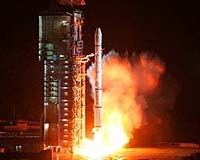
|
| ©Unknown |
| The current indigenously-developed Long March series of rockets can carry 9 tons to an orbit 300 km from Earth, or send satellites of 5 tons to a geosynchronous orbit 36,000 km away. |
"Chang'e I has already reached the launch site in Xichang of Sichuan Province, and is ready for launch due before the end of the year," he said in an online interview at www.gov.cn.
The launch date was not specified but earlier media reports have suggested it is likely by the end of this month.
Also by 2010, research work will begin on the moon probe project's second and third phases, which are landing on the moon and returning to Earth, he said.
In addition, research and development of a new design of a carrier rocket will be in full swing during the same period, he said.
Using non-toxic and non-polluting engines, the new generation carrier rockets are expected to be able to carry up to 25 tons to near-earth orbits and 14 tons to geosynchronous orbits, giving China the same launch capabilities as developed countries, he said.
The current indigenously-developed Long March series of rockets can carry 9 tons to an orbit 300 km from Earth, or send satellites of 5 tons to a geosynchronous orbit 36,000 km away.
In 2003, China launched its first manned space mission, making it the third country to send a lone human into orbit, after Russia and the United States.



A global pact of peace.. Science being funded for mans transition to go solar system wide. First child born in space (on the moon..). New salt water driven turbine engines/public transportation. World-wide free healthcare. Hunger/Starvation a thing of the past. Mental Hygiene on such a rise psychologists and pharmaceutical companies searching for work. Last Nuclear warhead disarmed. Free environmentally friendly energy for all.
In several ways Star Trek had a lot going for it.